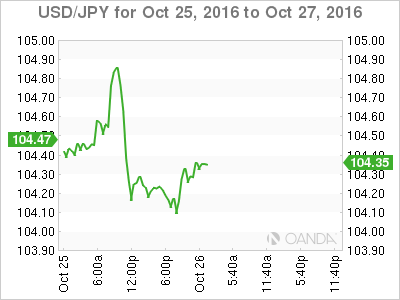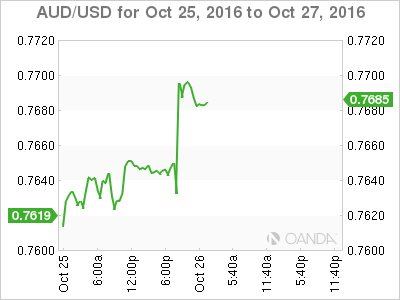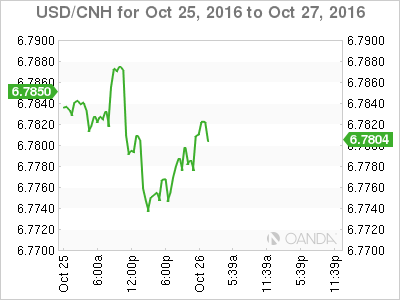Dollar U-Turns
US equities turned lower overnight as the US Consumer Confidence Index printed well below market expectations.
The WTI traded heavy after Russia appeared to backtrack from any production cap accord. We could see further pressure on equity markets because oil prices plunged in late NY trade after the API reported a much larger than expected build in US crude inventories, which surged to 4.8 million barrels cancelling out last week’s 5.2 million barrel draw.
Fixed income volatility remains tepid ahead of next week’s dearth of Central Bank meetings.
The USD rallied early in New York but ran into a bout of trader long dollar anxiety, which heightened after the US consumer confidence figure fell acutely for October and had negative revisions for September. The sentiment index fell from 104.1 to 98.6 versus 101.5 expected. The fall in the Consumer Index is a clear sign that the divisive build up to the US election is weighing on consumer optimism, as consumer views on the present situation, expectations for the future and jobs all declined.
After trading to 104.80, the USD/JPY made an abrupt U-turn on the data, which highlights just how sensitive traders are to US economic data, as the markets run hyper-twitchy ahead of the US election.
Lower oil prices will likely weigh on short term risk sentiment, despite the USD/JPY remaining tentatively supported on dips; short term momentum is certainly lower in early APAC trade. Given how intrinsically bearish the market’s view on risk sentiment is these days, the fear is that current longs could get squeezed if equity markets tumble.
Moving forward, the JPY should continue trading with a softer bias versus the USD as yesterday’s break above the 104.35 resistance was a constructive move for USD bulls.
Interest rates differential could suggest a move higher in USD/JPY. If the week closes above 104.50, it could open the door for an aggressive move to 106, as it would signal that the market is comfortable entering into a higher USD/JPY range.

After tracking the Canadian dollar most of the Asia session yesterday, sentiment then shifted to the broader USD bias overnight. The AUD had a relatively resilient 24 hours, as it was initially buffered after China’s iron ore futures popped to a new 2016 high and as the Dalian exchange on iron ore surged 6% to limit up.
In the NY session, the AUD remained supported, but markets are trading mixed ahead of the key Australia’s Q3 CPI data.
The Q3 CPI data came in much better than expected with the headline printing .7 % vs. .5 % Q o Q, and the trimmed mean at .4% in line with expectation. Certainly, a Goldilocks number for the RBA that indicates inflation if ticking higher supporting the notion that developed economies are re-inflating ex-Japan, which basically cements the consensus view that the RBA will remain on hold through year end.

The PBOC is allowing greater flexibility in the USD/CNH trading band, so activity is running well above average as trade position is for further Yuan depreciation heading into year-end.
Overnight, the USD/CNH sold on the back of the broader USD sell off, and the weaker long USD/CNH positions were stopped out on a break of 6.78 level. The markets are very controlled as open market forces are dictating recent yuan moves.

The ringgit had a good day yesterday, as foreign investor appetite for MYR bonds picked up, outweighing the negatives from political risk and current account narrowing. I suspect that investors are looking at the current political risk premium and have fixed the MYR relative to the rest of USDASIA. We could see some bargain hunting take shape in the days ahead.
